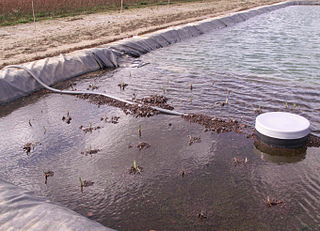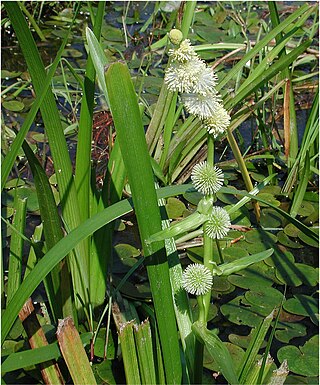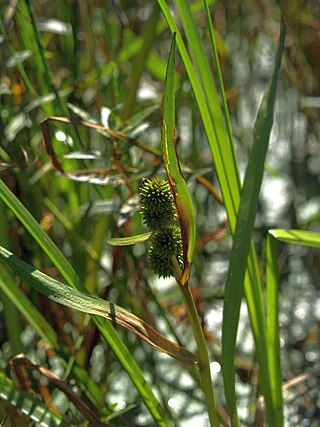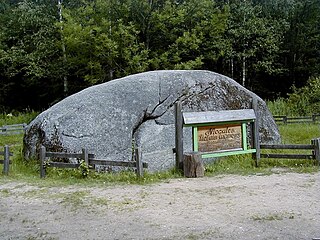
Reed is a common name for several tall, grass-like plants of wetlands.

Sparganium (bur-reed) is a genus of flowering plants, described as a genus by Linnaeus in 1753. It is widespread in wet areas in temperate regions of both the Northern and Southern Hemispheres. The plants are perennial marsh plants that can grow to 3.5 m, with epicene flowers.
Bolshayne Fen is a wetland in southeast Devon, England. It has an area of 1.62 hectares.

The River Rom, also known as the River Beam below its confluence with the Ravensbourne, is a tributary of the River Thames in England that flows through east London suburbs surrounding the metropolitan centre of Romford, part of it forming a section of the boundary between the London boroughs of Barking and Dagenham and Havering. The Rom is culverted for a brief midsection as it passes through the centre of Romford.

Sparganium natans is a species of bur-reed known by the common names least bur-reed and small bur-reed. It is a water circumboreal plant inhabiting North America, Europe, West Asia and Japan. It is usually found submersed in shallow, calm water. This bur-reed has thin, flexible, grasslike leaves which float in the water. Plants that spend more time out of water at the waterline are tougher and have shorter leaves. The plant bears two inflorescences, the staminate type being a rounded white filamentous ball and the pistillate type a sphere of thick, green, pointy peduncles. The fruits are small green or brown achenes.

A lava filter is a biological filter that uses lavastone pebbles as support material on which microorganisms can grow in a thin biofilm. This community of microorganisms, known as the periphyton break down the odor components in the air, such as hydrogen sulfide. The biodegradation processes that occurs is provided by the bacteria themselves. In order for this to work, sufficient oxygen as well as water and nutrients is to be supplied.

Sparganium eurycarpum is a species of bur-reed known by the common names broadfruit bur-reed and giant bur-reed. It is native to wetlands in Eurasia and North America. It is a clonal perennial, spreading by below-ground rhizomes. The common name, bur-reed, arises from the distinctive round clusters of fruits that take the form of a mace. It can be distinguished from all other species of bur-reed by the presence of two stigmas.

Polygonum erectum, commonly called erect knotweed, is a North American species of herbaceous plant in the buckwheat family (Polygonaceae). It is found primarily in the northeastern and north-central parts of the United States, but with scattered populations in other parts of the US and also in Canada.
Branched bur-reed is a common name for several plants in the genus Sparganium and may refer to:
Trodds Copse is a 25.23 hectare biological Site of Special Scientific Interest (SSSI), in central Hampshire, notified in 1989. It comprises ancient semi-natural woodland, unimproved meadows and flushes.

Sparganium angustifolium is a species of flowering plant in the cat-tail family known by the common names floating bur-reed and narrowleaf bur-reed. It has a circumboreal distribution, occurring throughout the northern latitudes of the Northern Hemisphere. It is an aquatic plant, growing in water up to 2.5 meters deep. Its habitat includes acidic, low-nutrient freshwater bodies such as ponds, lakes, slow-moving streams, and ditches. It can become abundant, practically covering the surface of the water. It is a perennial herb producing a floating stem with long, narrow, flattened leaves which can be quite long, sometimes reaching over two meters. It is monoecious, individual plants bearing both male and female inflorescences. These are spherical, the male inflorescence a ball of stamens and the female inflorescence a ball of developing fruits.

Sparganium emersum is a species of flowering plant in the cat-tail family known by the common names European bur-reed and unbranched bur-reed. It has a circumboreal distribution, occurring throughout the northern latitudes of Eurasia and North America. It is an aquatic plant, growing in shallow water bodies such as ponds and streams. It can become abundant at times. It is a perennial herb producing a floating stem up to 2 meters long. The leaves may be limp and floating or stiff and erect, emerging above the water surface. The leaves are flat and straplike, sometimes with a triangular, keeled base that can help distinguish it from the similar Sparganium angustifolium. It is monoecious, individual plants bearing both male and female inflorescences. These are spherical, the male inflorescence a ball of stamens and the female inflorescence a ball of developing fruits growing beneath the male spheres.

Sparganium glomeratum, the clustered bur-reed, is a species of bur-reed. It is a water plant native to high elevation lakes and marshes of Europe, Asia, and North America. North American populations were doubted as introduced due to its scarce and scattered populations, but a recent herbarium survey found more localities of the species in the central of Canada, concluding the species as circumpolar species.

Sparganium americanum, American bur-reed, is a perennial plant found in the United States of America and Canada. Though this species resembles a grass, it is a type of bur-reed. This species is important for conservation purposes because it has the ability to remove nitrogen and phosphorus runoff from water, like many other wetland species. By doing this, it protects waterways from excess nitrogen which can cause eutrophication. This increased nitrogen is especially a problem during the farmers’ growing season. During this same time frame the S. americanum is growing and taking up nitrogen.
Floating bur-reed is a common name for several plants and may refer to:
Machynys Ponds is a Site of Special Scientific Interest (SSSI) in Carmarthenshire, Wales, designated in 1993 for its botanical features.

Nīcgale forest is Latvia protected landscape area in Augšdaugava Municipality, in Nīcgale Parish, east of Nīcgale. At the eastern point of the territory is Nicgale Great Stone.

Sparganium fluctuans is a species of bur-reed found in North America known by the common name floating bur-reed. It is listed as endangered in Connecticut.














